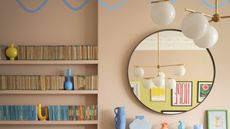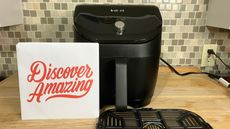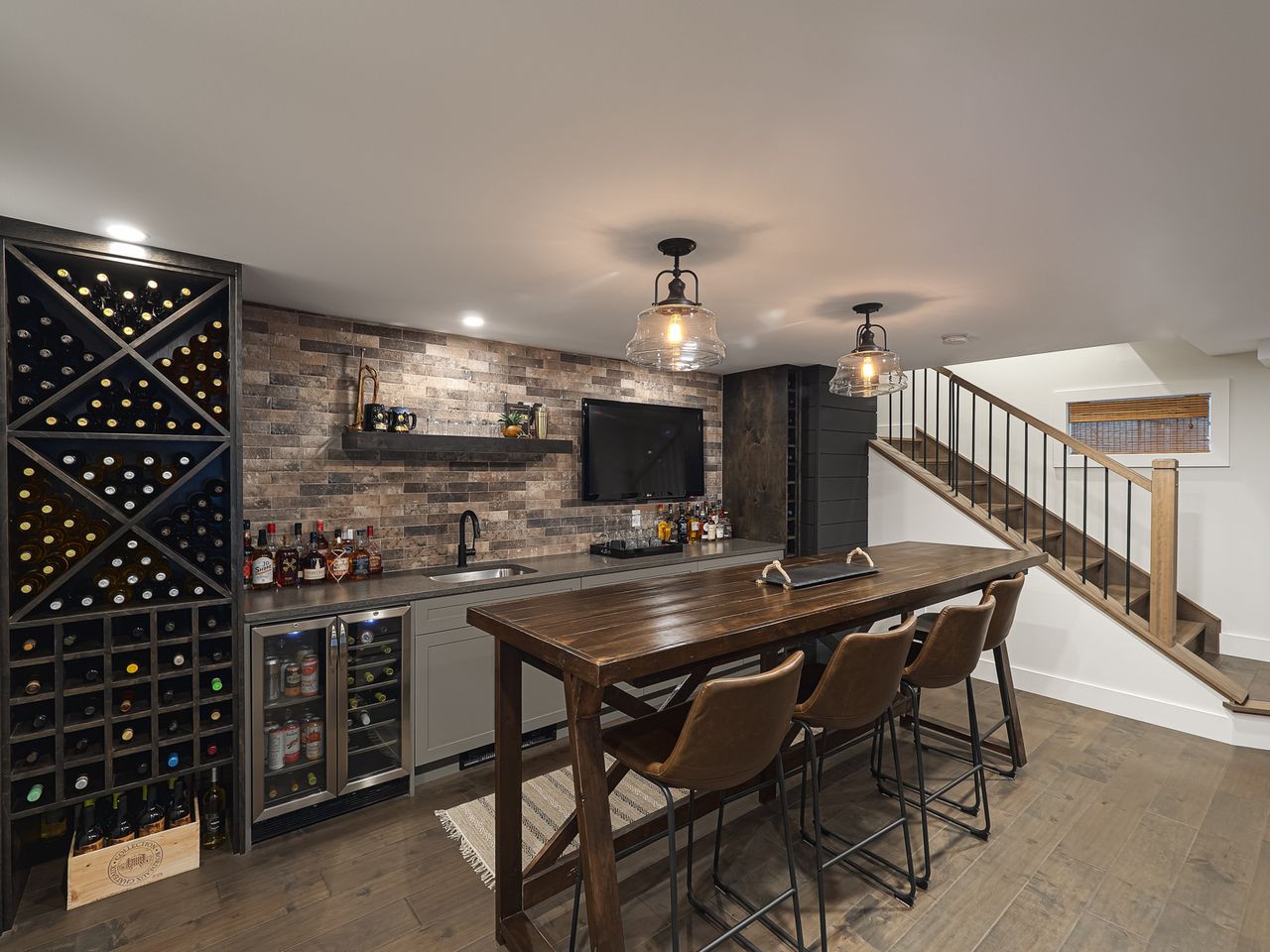

Looking for basement bar ideas? Well, we have you covered (plus might we add, you are winning at life). Basements get a bit of a bad rap for being dark, dank spaces, with no light and low ceilings, but don't let any of those deter you from creating your very own speakeasy. They can be transformed into gorgeous, stylish, light-filled spaces that you will be desperate to get entertaining in.
So we have rounded up all our favorite looks to inspire you to get making the most of your basement. From really easy ideas, like adding a cute bar cart to creating a fully stocked bar underneath your home, we are sure you'll find plenty of basement bar inspiration right here...
- Find plenty of basement bedroom ideas too in our gallery.
1. Pick the best layout for your basement bar
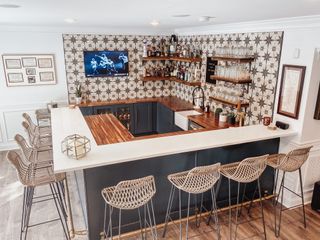
Now the layout of your basement bar will probably come down to how much space you have. But do plan your layout based on how you want your space to be used. Will it be a stand-up bar where your guests pick up a drink, mull for a bit and then take to a sofa? Or are you thinking a more permanent setup, with a seating area for eating and drinking?
If you are going for the latter we'd recommend, to create the feel of an actual bar, either go for an L-shaped bar, like the gorgeous space above by @jh_styletherapy, which is ideal if you are after a more compact design. Or you could opt for a galley shape with a bar running along the wall and a seating area in front.
'When designing your basement home bar, always take comfort and accessibility into account. While the size and layout largely depends on the available space, also consider how many people you plan to entertain at any given time. Most standard home bar designs are at least 6’ long to accommodate three bar stools.' says Victoria Suto of KegWorks.
'An often overlooked detail is a bar foot rail. Adding a foot rail not only adds to the aesthetic to your home bar, but provides increased comfort for guests who prefer to stand.'
'If you plan to build a wet bar you will need to take the proximity to plumbing into account when deciding on the placement and layout of your home bar. Consider where your sink will be located and don’t forget about ice! While it may seem like a luxury, adding an ice maker will save you lots of time, hassle and money in the long run.'
Join our newsletter
Get small space home decor ideas, celeb inspiration, DIY tips and more, straight to your inbox!
2. Do you want a wet bar or a dry bar?

As you can probably guess by the name, a wet bar is one that has plumbing. A dry bar is usually more of a stand-up area where you can mix and serve drinks.
Adding a sink to your basement bar, maybe even a glass wash will mean you aren't having to keep running upstairs for water or clean glasses. If you do want plumbing, you'll make everything a whole lot easier for yourself if you position your bar underneath existing plumbing in your home – say under a kitchen or a bathroom. That way you can just extend your water pipes rather than add completely new ones and getting water and drainage down to your basement won't be as big a job and you'll save on money too.
3. Incorporate beer taps for the ultimate at home bar
If you want to get serious with your at-home basement bar, adding in taps will take it to the next level. For this, you are going to want to first consider the layout of your system and where all the basic parts are going to go.
For a basic set you are going to need:
- A keg (or two): this is where your beer will be store and you'll probably want to keep it refrigerated.
- A kegerator: this is a fridge for the keg which can sit underneath a countertop.
- A CO2 canister: this is what will give your beverage fizz and froth.
- Beer line: this is what brings the beer up to the tap, you'll need to make sure you can access it easily for cleaning (every two weeks is recommended).
- A tap: to pour your beautiful beer.
- You will probably also want to add a drip tray.
'Adding a kegerator in your basement bar is very easy. When choosing a kegerator for your home bar look for an under-counter kegerator unit. This style of kegerator is designed to be installed in an enclosed space because it can properly expel warm air from the refrigeration unit. Installing a built-in kegerator requires cutting a hole in your bar top for the draft tower. This process may be challenging depending on the material you select as granite and marble can crack when drilling. If you’re using a professional to install your bar top, inquire on the process for drilling the hole needed for your tower ahead of time.' explains Victoria.
'The biggest challenge with adding a kegerator to your basement bar is carrying a full keg down a flight of stairs. If you’re transporting kegs solo, we recommend purchasing smaller, sixtel kegs or consider buying a keg dolly that is designed to haul kegs up and down stairs.'
4. Think about lighting
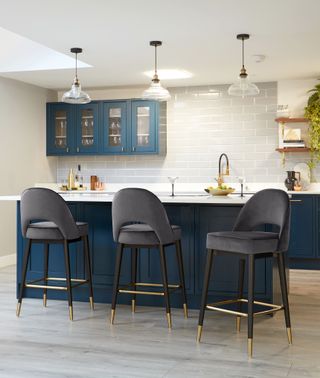
Lighting is key. It's what takes a basement from dingy to delightful, and for a bar lighting is all about creating atmosphere. No one wants a bright spotlight in their face as they sip on your homemade martinis, so keep your lighting soft and low.
If you have a seating area, pendant lights look lovely hung in groups to create a focal point and for the rest of the space dimmable spotlights will allow you to adjust the lighting with the mood.
'A good lighting scheme for a home bar or basement bar room is a must. Usually these areas have no windows with little to no natural light, so it is important the whole space is well lit. A combination of task lights and decorative fittings works best in this set up, providing bright lighting for key areas and mood lighting for entertaining.' explains Julian Page, Head of Design at BHS.
'Downlighters are good for over the bar as they provide bright illumination, perfect for preparing cocktails. A spotlight bar is ideal for this type of space, as the individual lights can be directed to where tasks are performed. Or opt for a colorful pendant to bring in a pop of colour, try an LED contouring light strip which will highlight the underneath of the bar and add additional minimalist statement.'
5. Go for an elegant stand up bar area
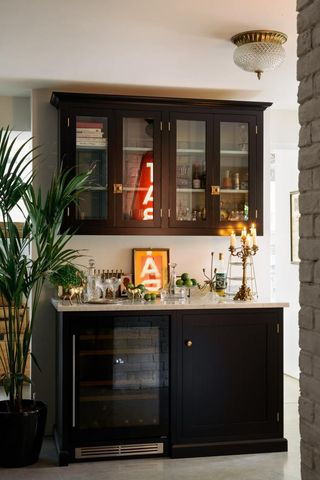
Let's move on from the practical stuff and talk decor! If you are looking for a more low maintenance, easy way to add a home bar to your basement, a stand-up dry bar area like this one could be all your need. Just a worktop to serve your drinks and keep your bar accessories, glass cabinets to keep your glasses on show and space for an under-counter fridge.
This bar space was designed using deVOL kitchen cabinets and has a such an elegant feel to it with the dark cabinetry and marble top. You could go for the same cabinetry as your kitchen to link the two areas together and make the basement space feel more like an extension of the upstairs space.
6. Add atmosphere with dark colors
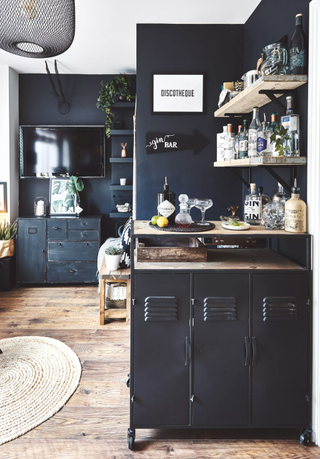
Sometimes all a basement needs to take it from the dingy space under your home is a bold color scheme and some cute decor. This basement nook has been transformed simply by adding some shelves and positioning a trolley underneath them.
Don't be afraid to go dark in your basement either. There's a tendency to always want to keep small spaces bright and airy but if you are adding a bar down there you want it to feel cozy and atmospheric.
'It is often a misconception that dark colors make a room feel smaller. In fact, this can work brilliantly in compact spaces, and can help a room to feel co-ordinated and cozy. Paint is a great way to define a space, so don’t be afraid to introduce different colors to the walls. We love to mix it up with different tones to create interest but also to reflect our clients’ individual style and personality.' explains Jen & Mar from Interior Fox.
- Find more home bar ideas so brilliant you won't even miss the pub
7. Add a wine room
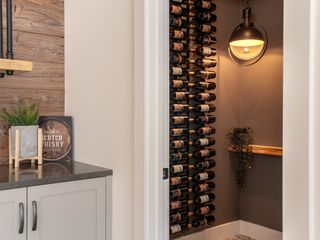
If your wine collection is far too extensive to be housed in wine racks, consider adding a wine room to your basement bar. Not only is this a practical storage idea it can also look lovely too – case in point with this space here.
Just make sure your basement is suitable for storing your wine. Usually, they are actually the perfect place – no direct sunlight, no massively fluctuating temperatures – but do check there's no mold at the temperature doesn't drop below 40°F, the ideal temperature for storing wine is 55°F.
8. Or make your wine collection a feature
A post shared by Board & Vellum (@boardandvellum)
A photo posted by on
Love this basement bar design by Board & Vellum. If you don't have the space for a wine room, make your collection a feature of your bar. This design uses what's essentially a large peg board to store the wine horizontally – this is actually how it best kept – but you could create a similar look with open shelving and wine racks.
9. Add an island for socialising
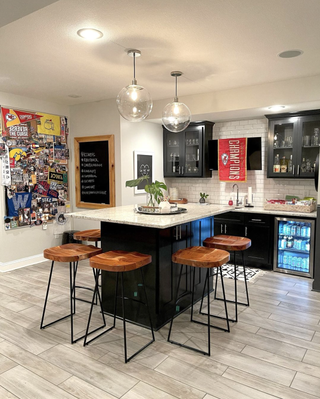
Just check out @lifelovelarson's amazing basement bar! What makes this space really feel like an actual bar is the seating. You want your guests to have a place to perch that feels sociable, and an island is the perfect spot for just that. An island is a great alternative to a traditional bar if you don't have the space to add a long seating space. You can fit in just as much sitting and gives a focal point to your room too.
10. DIY a basement bar
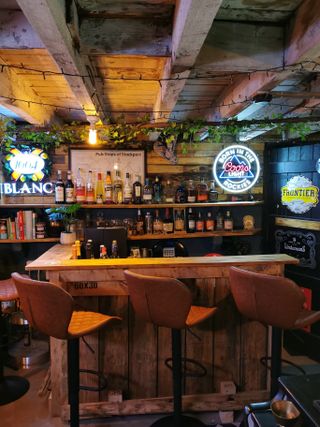
Very jealous of this set up that @one_two_miss_a_few have created in their basement. If you are working with a smaller budget and want to give your cellar or existing basement a bit of a revamp, why not DIY your own bar? This bar was all created using old wooden pallets, and then reclaimed wooden shelving to create the countertop.
The space has been paneled too, making it cozier and more inviting, plus adding to the very cool industrial vibe going on here. The retro bar lights are a fab addition and really give it that feel of being a social space.
That's our next lockdown project sorted then!
How much does it cost to put a bar in a basement?
The cost of putting a bar in your basement ranges depending on the size of you bar the fittings, the plumbing and the finish. You can add a dry bar to your basement for under $1,000 but a wet bar is going to cost more as you'll have to hire plumbers. You would be looking at paying anywhere between $4,000 and $20,000, and that's if your basement has already been converted to some degree.
'The cost to install a bar in your basement varies widely. Like any home improvement project, cost depends on labor and materials. If you’re handy, building a home bar is a great DIY project vs hiring a contractor. Things like plumbing, electrical, appliances, and the overall size of your bar play a large part in the overall cost of building a bar in your basement. You can save money by sourcing some materials second hand and recruiting friends to help (in exchange for an open invite, of course).' says Victoria Suto of KegWorks.
Hebe joined the Real Homes team in early 2018 as Staff Writer before moving to the Livingetc team in 2021 where she took on a role as Digital Editor. She loves boho and 70's style and is a big fan of Instagram as a source of interiors inspiration. When she isn't writing about interiors, she is renovating her own spaces – be it wallpapering a hallway, painting kitchen cupboards or converting a van.

